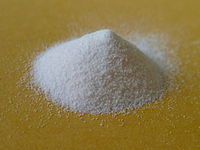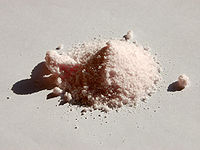- Manganese(II) sulfate
-
Manganese(II) sulfate 
Manganese(II) sulfate monohydrate
Manganese(II) sulfate tetrahydrateManganese(II) sulfateIdentifiers CAS number 7785-87-7  ,
,
10034-96-5 (monohydrate)
10101-68-5 (tetrahydrate)PubChem 24580 ChemSpider 22984 
UNII IGA15S9H40 
EC number 232-089-9 ChEMBL CHEMBL1200557 
RTECS number OP1050000 (anhydrous)
OP0893500 (tetrahydrate)Jmol-3D images Image 1 - [Mn+2].[O-]S([O-])(=O)=O
Properties Molecular formula MnSO4 Molar mass 151.001 g/mol (anhydrous)
169.02 g/mol (monohydrate)
223.07 g/mol (tetrahydrate)Appearance pale pink crystalline solid (tetrahydrate) Density 3.25 g/cm 3 (anhydrous)
2.95 g/cm3 (monohydrate)
2.107 g/cm3 (tetrahydrate)Melting point 710 °C (anhydrous)
27 °C (tetrahydrate)Boiling point 850 °C (anhydrous)
Solubility in water 393 g/L (24 °C)
262 g/L (100 °C)Structure Crystal structure orthogonal (anhydrous)
monoclinic (monohydrate)
monoclinic (tetrahydrate)Hazards MSDS ICSC 0290 EU Index 025-003-00-4 EU classification Harmful (Xn)
Dangerous for the environment (N)R-phrases R48/20/22, R51/53 S-phrases (S2), S22, S61 NFPA 704 Related compounds Other cations Chromium(III) sulfate
Iron(II) sulfate sulfate (verify) (what is:
sulfate (verify) (what is:  /
/ ?)
?)
Except where noted otherwise, data are given for materials in their standard state (at 25 °C, 100 kPa)Infobox references Manganese(II) sulfate usually refers to the inorganic compound with the formula MnSO4(H2O). This pale pink deliquescent solid is a commercially significant manganese(II) salt. Approximately 260 thousand tonnes of manganese(II) sulfate were produced worldwide in 2005.[1] It is the precursor to manganese metal and many other chemical compounds. Mn-deficient soil is remediated with this salt.
Structure
Like many metal sulfates, manganese sulfate forms a variety of hydrates: monohydrate, tetrahydrate, pentahydrate, and heptahydrate. The monohydrate is most common. All of these salts dissolve to give faintly pink solutions of the aquo complex [Mn(H2O)6]2+. The pale pink colour of Mn(II) salts is highly characteristic.
Applications and production
Typically, manganese ores are purified by their conversion to manganese(II) sulfate. Treatment of aqueous solutions of the sulfate with sodium carbonate leads to precipitation of manganese carbonate, which can be calcined to give the oxides MnOx. In the laboratory, manganese sulfate can be made by treating manganese dioxide with sulfur dioxide:[2]
- MnO2 + SO2 → MnSO4
Manganese sulfate is a by-product of various industrially significant oxidations that use manganese dioxide, including the manufacture of hydroquinone and anisaldehyde.[1]
Electrolysis of manganese sulfate yields manganese dioxide, which is called EMD for electrolytic manganese dioxide. Alternatively oxidation of manganese sulfate with potassium permanganate yields the so-called chemical manganese dioxide (CMD). These materials, especially EMD, are used in dry-cell batteries.[1]
References
- ^ a b c Arno H. Reidies "Manganese Compounds" Ullmann's Encyclopedia of Chemical Technology 2007; Wiley-VCH, Weinheim. doi:10.1002/14356007.a16_123
- ^ John R. Ruhoff (1943), "n-Heptanoic acid", Org. Synth., http://www.orgsyn.org/orgsyn/orgsyn/prepContent.asp?prep=cv2p0315; Coll. Vol. 2: 315
Manganese compounds Categories:- Manganese compounds
- Sulfates
- Deliquescent substances
Wikimedia Foundation. 2010.

